Introducing the SF Concrete Roof - Fixed Triangle – an advanced non-penetrating solar mounting system designed for both residential and commercial concrete flat roof applications, as well as ground-based installations.
Engineered for efficiency and durability, this system features a pre-assembled triangular bracket design that significantly reduces installation time while providing exceptional structural stability under demanding environmental conditions.
? Technical Overview:
• Installation Types: Concrete roof and ground mount
• Wind Load Resistance: Up to 60 m/s
• Tilt Angle Options: 5°, 10°, 15°
• Snow Load Capacity: 1.4 kN/m²
• Material Composition: Anodized Aluminum AL6005-T5 & Stainless Steel SUS304
• Compliant Standards: GB50009-2012, EN1990:2002, ASCE7-05, AS/NZS1170, JIS C8955:2017, GB50429-2007
• Warranty: 10 years
?️ Installation Process Overview:
The system is delivered with pre-assembled triangle brackets and clamps for streamlined deployment:
1. Layout and mark positions for supports or concrete piers
2. Secure pre-assembled brackets using expansion bolts
3. Install and connect rails with integrated connectors
4. Position PV modules onto the rails
5. Fasten modules using pre-provided end and mid clamps
This solution combines engineering excellence with practical installation efficiency, making it an ideal choice for solar projects requiring reliability, speed, and international standards compliance.
Ideal for EPC contractors, project developers, and sustainability-driven organizations.
Feel free to reach out for technical specifications or collaboration opportunities.

Solar First Group Advancing Green Energy Through Innovative Photovoltaic Bracket Solutions
As solar energy accelerates globally, photovoltaic brackets play a critical role in maximizing land efficiency and power generation. At SNEC 2025 in Shanghai, Solar First Group’s General Manager Judy shared insights with Vico Solar on driving industry leadership through innovation and strategy.
Innovation and Service: Dual Pillars of Global Excellence
Founded in 2011 during the industry’s downturn, Solar First Group embraced "New Energy, New World" as its vision. Today, we lead in:
• BIPV Solutions
• Solar Tracking Systems
• Floating PV Plants
With products in 100+ countries and recognitions including the Malaysian Photovoltaic Building Invention Award and UK Photovoltaic Building Energy Award, our growth defies market challenges.
Judy’s Leadership Insights:
1.Continuous R&D: Iterative technological evolution.
2.Global IP Strategy: Patents secured in key markets (Africa, Japan, U.S.).
3.Collaborative Innovation: "We openly share select patents to advance the entire sector."
4.Service Differentiation: 24-hour on-site response via localized global networks – a rare industry commitment.
Solving Industry Pain Points
Addressing land scarcity and complex installations, our SNEC showcase featured:
• Flexible Supports: For mountainous/hilly terrain (high wind resistance, 40m+ spans).
• Smart Trackers: Adapting to 15% continuous slopes.
• Floating Systems: Enabling "blue economy" projects on lakes/reservoirs.
• BIPV Integration: Architecturally certified solutions (applied at Cambridge University and Uruguay Stadium).
Judy: "We transform non-arable land and water into high-efficiency power stations."
Global Strategy for Sustainable Growth
Amid trade complexities, our approach includes:
• Technology Roadmap:
Scaling floating PV and BIPV innovations
Integrating perovskite tech with flexible structures
• Localized Operations:
European manufacturing bases (expanding globally)
Market-driven R&D and patent development
Sustained 24/7 service excellence
Driving Local Impact from Xiamen
As a hometown pioneer, Solar First Group:
• Guides Xiamen businesses in green energy adoption
• Converts industrial zones/wastelands into smart microgrids
• Develops virtual power plants for industrial clusters
Join Our Mission
We invite partners and clients to collaborate in reshaping energy infrastructure through engineering excellence.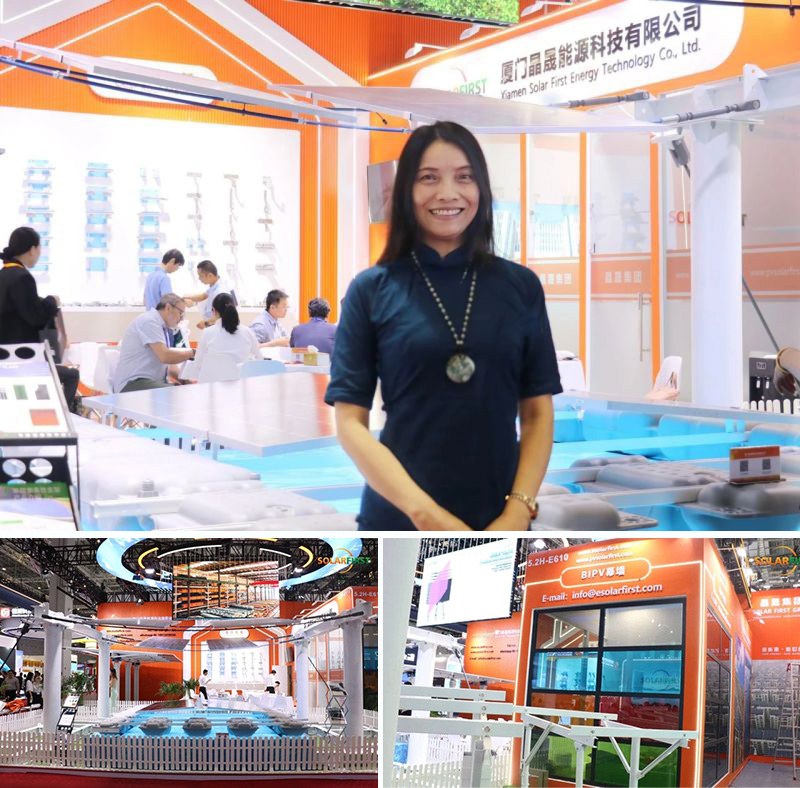
Solar First Group Honored as Influential Photovoltaic Mounting Brand at the 14th Polaris Cup Awards
We are proud to announce that Solar First Group has been awarded the “Influential Photovoltaic Mounting System Brand” at the 14th “Polaris Cup” Photovoltaic Influential Brand Awards on September 9, 2025.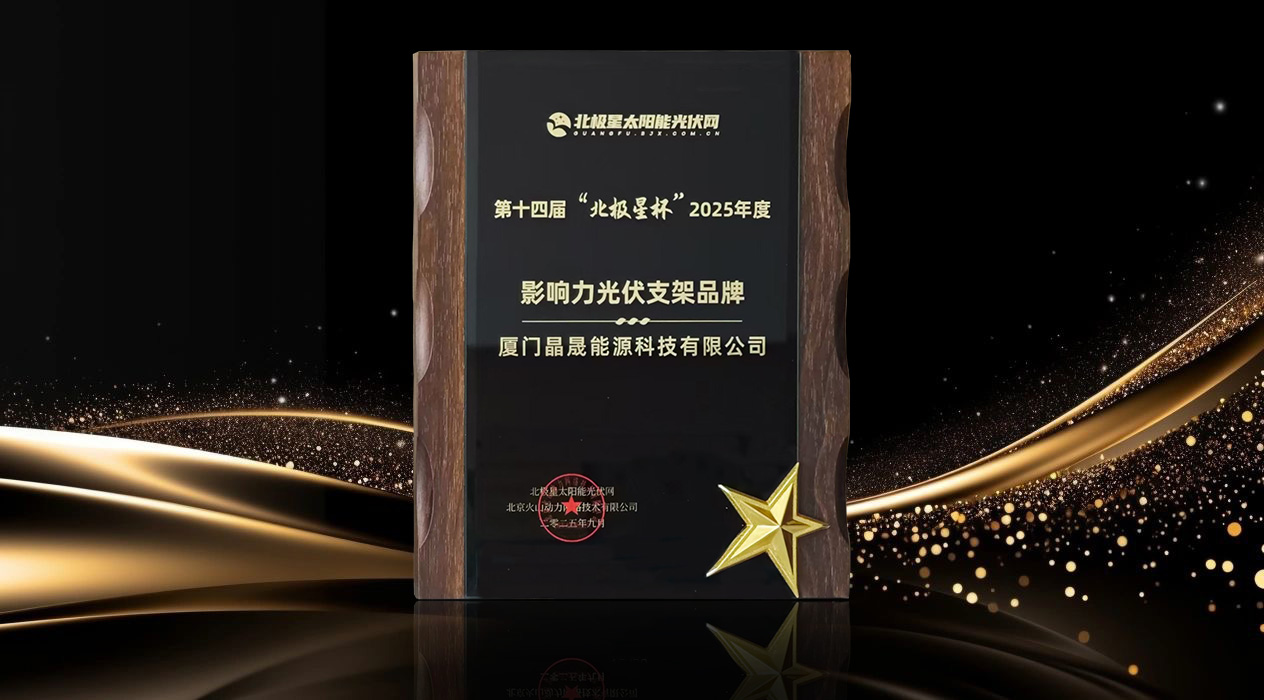
This accolade reflects the group's proven product capabilities and extensive influence across the photovoltaic market. As a national high-tech enterprise, Solar First Group specializes in the R&D, production, and sales of renewable energy products, delivering comprehensive solar solutions that include solar power generation systems, source-grid-load-storage smart energy integration, solar trackers, floating PV systems, BIPV, and flexible mounting structures.
The company’s products and services are now operational throughout China and in more than 100 countries and regions worldwide. Solar First has been repeatedly recognized as a specialized, refined, and innovative SME, a Science and Technology Giant enterprise, and a Xiamen Contract-abiding and Credit-worthy Enterprise. The group also maintains ISO9001, ISO14001, and ISO45001 certifications, and holds 6 invention patents, over 60 utility model patents, and 2 software copyrights.
Receiving the Polaris Cup underscores Solar First’s commitment to providing highly reliable and adaptable mounting solutions, even for the most complex application scenarios. It also reinforces the group’s role as a trusted innovator in the support structures segment of the global solar industry.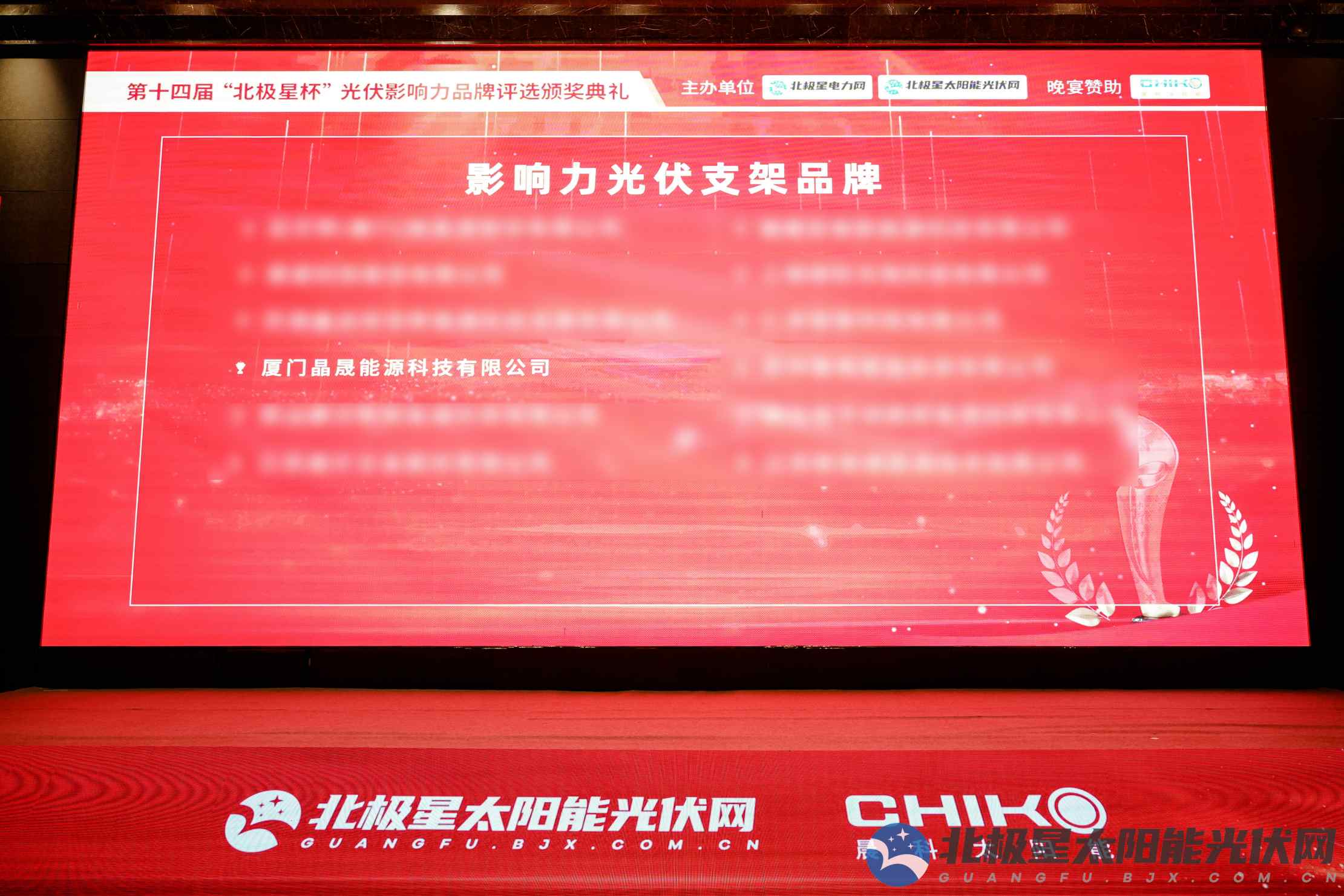
Looking ahead, Solar First Group will continue to adhere to its mission of “New Energy, New World,” advancing technology innovation and service excellence in photovoltaic mounting and integrated energy solutions. Through differentiated products and full life-cycle services, we are committed to supporting the global transition toward a green, low-carbon future.
We thank our partners, clients, and team members for their ongoing support and collaboration.
Solar First Group Shines at IGEM, Secures Two Prestigious Booth Awards
We are proud to announce that Solar First Group was honored with two prestigious awards at the International Greentech & Eco Products Exhibition & Conference Malaysia (IGEM), held at the Kuala Lumpur Convention Centre on October 15:
🏆 Best Sustainable Booth (2nd Runner-Up)
🏆 Best Display Booth Winner
These accolades reflect not only our team’s dedication and creativity but also the industry’s recognition of our innovative approach to sustainable energy solutions.
At Booth 1040 in Hall 1, we showcased a comprehensive range of photovoltaic systems, including:
• Rooftop Mounting Structures
• Ground-Mount Systems
• Solar Tracking Systems
• Floating Solar Systems
• BIPV Carports
Our booth was designed in alignment with our core sustainability values—utilizing eco-friendly materials and energy-saving technologies—making it a standout feature of the exhibition and reinforcing our commitment to a greener future.
Winning these awards underscores Solar First Group’s leadership in product innovation and our ongoing contribution to the green energy transition in Southeast Asia. We extend our sincere gratitude to our partners, clients, and the event organizers for their support and recognition.
Looking ahead, we will continue to deepen our R&D efforts and strengthen our understanding of local market needs across Southeast Asia. Solar First Group remains dedicated to delivering high-performance, tailored solar solutions and supporting Malaysia and the broader region in achieving a sustainable, low-carbon future.
Join us as we power tomorrow with clean energy. 🌞

Solar First Group Shines at Saudi Solar Exhibition with Full-Scenario Solutions
From October 12-14, Solar First Group showcased its innovative photovoltaic solutions at Solar & Storage Live KSA in Riyadh. Displaying applications from ground-level to rooftop installations, the company's market-tailored products demonstrated exceptional reliability, attracting significant industry attention. 👏👏👏
🏜️ Engineered for Extreme Climates
Addressing Saudi Arabia's high-temperature and sandy environment, Solar First's solutions feature heat-resistant and UV-protected aluminum alloys. These lightweight yet durable systems suit various local structures - from concrete flats to metal roofs - effectively withstanding thermal expansion and sandy winds.
Multi-Scenario Solutions
The reinforced tracking support system ensures reliable desert performance with enhanced wind resistance. BIPV curtain walls seamlessly integrate power generation with architectural design, while fixed ground-mounted systems offer easy installation and stable operation for utility-scale projects.
🎯 Supporting Vision 2030
Aligning with Saudi Arabia's energy transition goals, Solar First is strengthening local partnerships and expanding customized services. During the exhibition, the team gained valuable insights from discussions with local enterprises and experts, further refining their understanding of regional requirements.
Moving Forward
Guided by the "New Energy, New World" vision, Solar First remains committed to technological innovation and market-focused solutions, supporting the Middle East's sustainable energy transformation through global collaboration.

Solar First Group's Lingao County Floating Solar Project Successfully Connected to Grid, Earns Media Praise!
? Exciting News from Xiamen Solar First Group!
We are proud to announce that our floating photovoltaic project in Lingao County, Hainan Province, has successfully achieved full grid connection and is now operational. This milestone has drawn significant recognition and praise from local government and media outlets.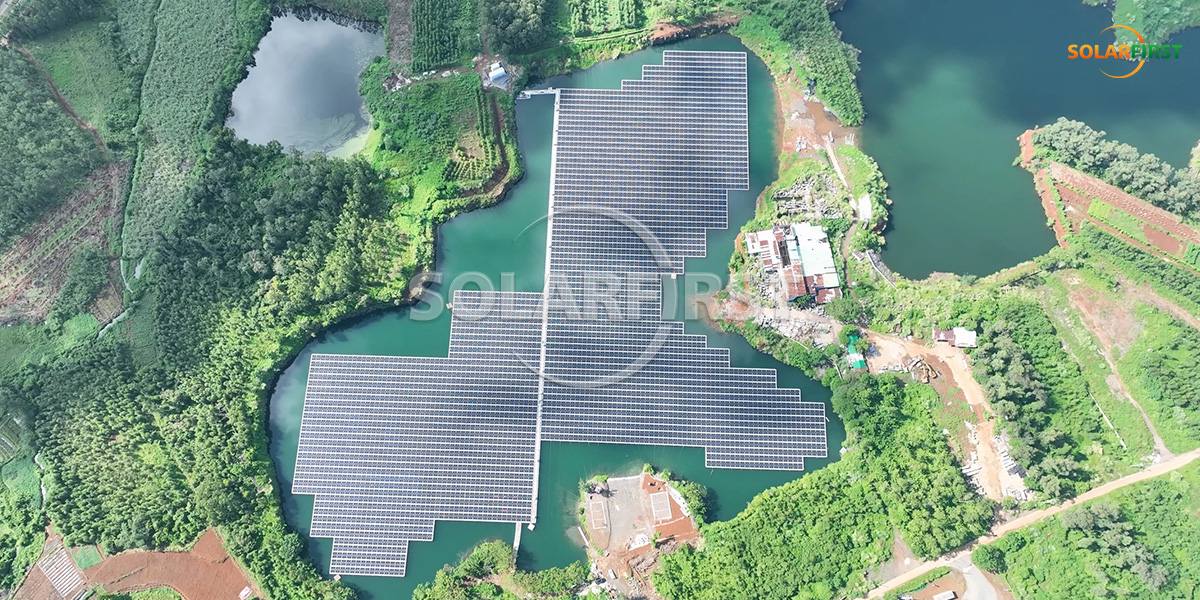
? Revitalizing Abandoned Mines: "Blue Armor" Harnessing Green Energy
Situated on a repurposed mining pond in Bohou Town, the project spans 114.4 mu (7.6 hectares) with a total installed capacity of 5.8 MW. More than 10,000 solar panels are neatly arranged on the water—like “blue armor”—creating a symbiotic model of clean energy generation and ecological remediation.
Operating under a full grid-connection mode, the power station generates approximately 9.66 million kWh of electricity annually. This translates to saving about 2,946 tons of standard coal per year and significantly reducing emissions including CO₂ and SO₂. A perfect example of turning wasted land into continuous green energy!
⚙️ Tackling Technical Challenges with Innovative Floating Systems
Floating PV projects entail more complex requirements than ground-mounted systems—including buoyancy, stability, and environmental adaptability. Solar First overcame these hurdles using our self-developed HDPE floating system. This lightweight, eco-friendly solution allows rapid installation without heavy machinery and offers high resistance to extreme conditions such as typhoons and heavy rainfall.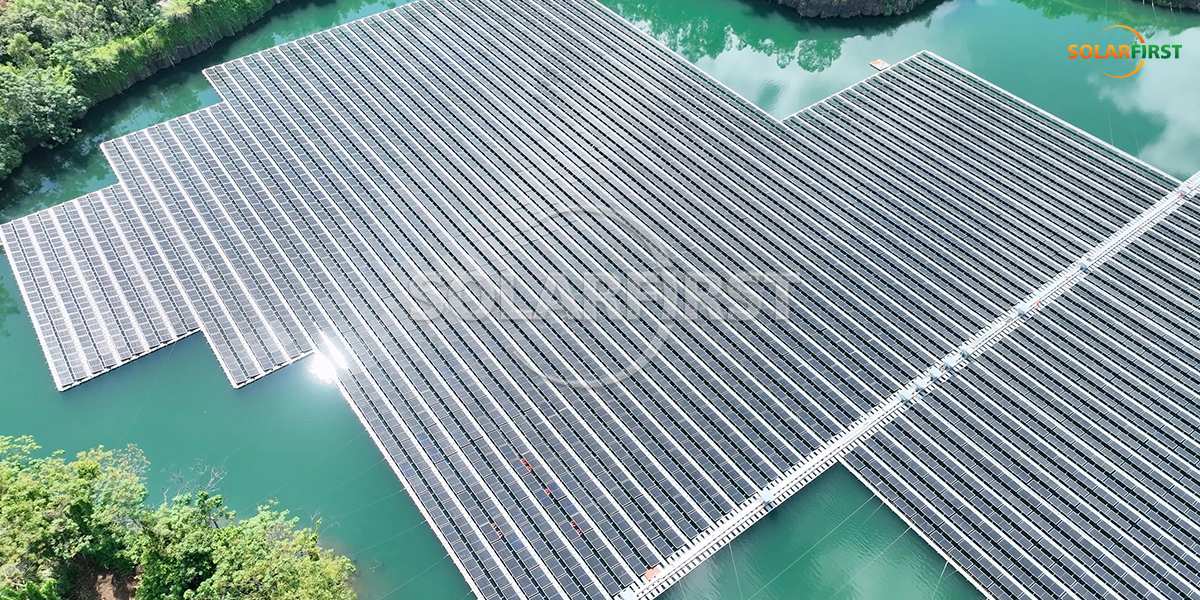
? Technology-Driven Leadership in Renewable Energy
As a national high-tech enterprise, Xiamen Solar First is committed to the philosophy of "New Energy, New World." We specialize in R&D and manufacturing of solar PV systems, floating structures, and smart energy integrations. With 6 invention patents, over 60 utility model patents, and international certifications, our products and services extend to more than 100 countries and regions.
The Lingao project exemplifies our dedication to the belief that “lucid waters and lush mountains are invaluable assets.” Moving forward, we will continue to advance innovation in renewable energy, promote initiatives like “PV + Ecological Restoration” and “PV + Rural Revitalization,” and contribute to global energy transition and sustainable development.
Join us in building a greener, smarter future!??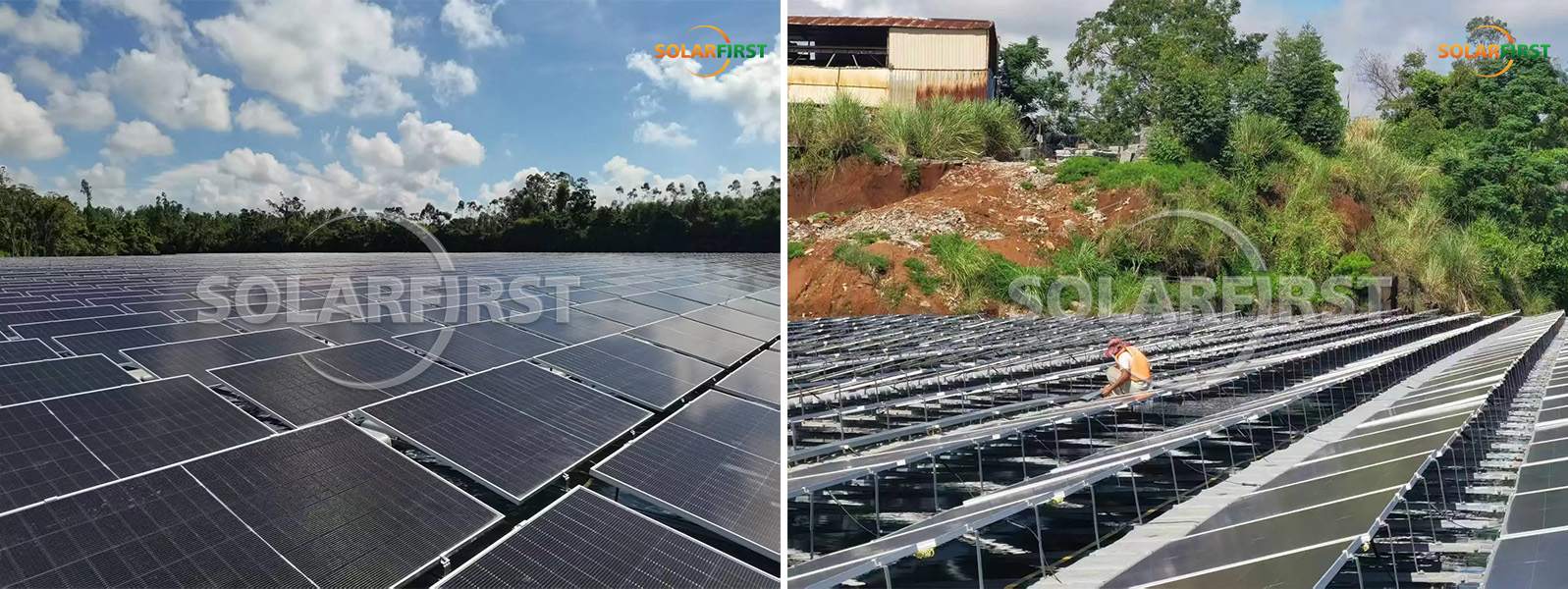
Solar First Shines at Malaysia’s Green Energy Exhibition, Showcasing Diverse PV Solutions
We are thrilled to share that Solar First made a strong impression at the International Greentech & Eco Products Exhibition & Conference Malaysia (IGEM), held from October 15–17 at the Kuala Lumpur Convention Centre.
At Booth 1040 in Hall 1, we presented a wide range of photovoltaic solutions—including rooftop mounting systems, ground-mounted systems, tracking systems, floating PV systems, and BIPV carports—designed to cover diverse application scenarios and support Malaysia’s clean energy transition.
Tailored Solutions for Southeast Asia’s Climate
As a key renewable energy market in Southeast Asia, Malaysia is rapidly advancing its solar project deployment. In line with the national Malaysia Renewable Energy Roadmap (MyRER), the country aims to achieve 31% renewable energy by 2025 and 70% by 2050.
To meet local challenges such as high temperatures, humidity, and coastal conditions, Solar First has optimized its products with enhanced corrosion resistance, structural stability, and ease of installation. Our rooftop systems are lightweight yet durable, while our ground-mounted and tracking solutions are built to perform across complex terrains and improve energy yield through intelligent design.
Expanding Applications for a Diversified Energy Mix
Our BIPV carport system delivering clean electricity while providing shade and shelter for vehicles. This aligns perfectly with Malaysia’s green building and urban sustainability goals.
Additionally, our floating PV systems make smart use of water surfaces such as lakes and reservoirs, saving land while leveraging the natural cooling effect of water to boost efficiency. Studies estimate Malaysia’s floating PV potential to be between 47–109 GWh annually, offering a promising pathway for scaling solar capacity.
Strengthening Our Presence in Southeast Asia
Solar First is committed to the Southeast Asian market and is actively engaging with Malaysia’s renewable energy initiatives, including the Green Electricity Tariff (GET) and Net Energy Metering 3.0 (NEM 3.0).
At the event, our team connected with local enterprises, project developers, and industry associations, gaining valuable insights into regional policies, project needs, and environmental considerations. These exchanges help us deliver more localized and adaptive solutions in the future.
Looking ahead, we will continue to focus on technology innovation and deepen our collaboration with partners in Malaysia and across the region. Together, we are driving the clean energy transition and building a sustainable, low-carbon future.


SolarFirst Delivers Custom Floating Solution for 15.6MWp Project on Challenging Malaysian Mine Lake
We are proud to showcase the successful completion of a 15.6MWp floating solar project on a former tin mine lake in Malaysia—a site with significant hydrological challenges.
The Challenge: An uneven seabed, depths of over 20 meters, and loose sandy soil demanded a floating structure with superior stability, anti-overturning capability, and a customized anchoring design.
Our Solution: After rigorous on-site comparison with other float providers, our TGW-03 frameless float system was chosen as the optimal solution. Key differentiators included:
✅ Enhanced stability and wind resistance from our "frame + float" design.
✅ Improved energy output due to superior module cooling.
✅ Faster installation with fewer metal components.
✅ A custom mooring system with pre-cast concrete blocks for complex seabed conditions.
This project demonstrates our commitment to providing technically advanced and reliable solutions for the most complex FPV environments.
We invite our connections in the industry to watch the video and learn how we can help unlock the potential of challenging water bodies for clean power generation.
SolarFirst - Powering a Cleaner Future, on Water.
Spiral Ground Pile Ground Support Installation Video Released!
The installation video of the spiral ground pile ground support has been released!
Reliable materials: Hot-dip galvanized or zinc-aluminum-magnesium coated steel, suitable for different environments and durable.
Flexible design: Multiple profiles are available for selection, and the structure is stable and reliable.
Installation steps
1️ ️ positioning pile driving: precise driving of spiral piles.
2️ ️ column installation: Fix the column to the ground pile with bolts.
3️ ️ assembly of the crossbeam: The purlin support is installed on the crossbeam, and then the crossbeam and the column are connected by bolts.
4️ ️ reinforcement structure: Bolts at both ends of the diagonal brace connect the column to the crossbeam, and clamps fix the column.
5️ ️ tie rod installation: install the tie rod connection piece on the column, and then install the tie rod.
6️ ️ purlins and components: Install the purlins in sequence and fix them to the crossbeams, and finally bolt the photovoltaic panels!
Solar Roof Mounting Adjustable Tilt Kit Advantages for Flat Roof and Metal Roof |Art Sign
Maximizing the use of solar energy depends not only on the number of solar panels, but more importantly on making existing solar panels work more efficiently. For customers who want to absolutely utilize their solar energy systems, fixed solar roof mounting systems have certain limitations, but Art Sign solar roof mounting brackets adjustable tilt kit can effectively overcome these limitations. This adjustable tilt kit gives you the flexibility to manually adjust your panel's angle, aligning them perfectly with the sun's position.
1)Suited for concrete flat roof and metal roof.
2)Adjustable type structure which has 3 angle range for options: 10-15°, 15-30°, 30-45°.
3)All the components will be pre-assembled.
10um thk. Anodized aluminum, stainless steel 304 bolts and nuts.
Design Strength:
2 kinds of design to meet the different wind load and snow load requirements.
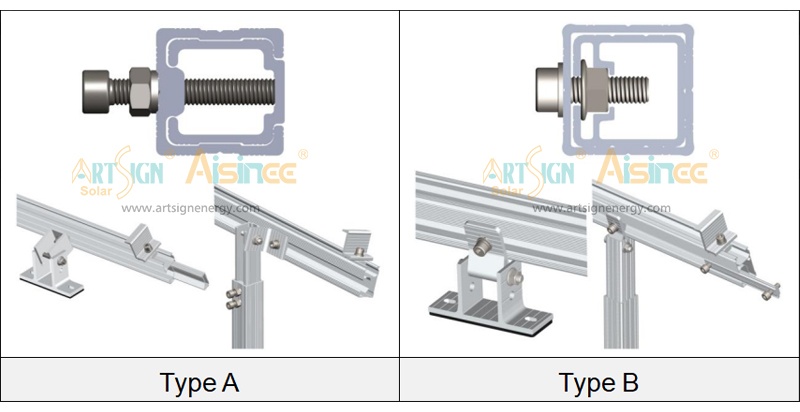
Key Advantages of Solar Roof Mounting Structure Adjustable Tilt Kit:
1)Adjust tilt angle: the solar altitude angle varies with the seasons, and fixed solar roof mounting can only maintain one tilt angle. However, Art Sign solar panel roof mount adjustable tilt kit can optimize the tilt angle in each season, thereby improving solar energy utilization by 5%-15%.
2)Applications to different roof types: for flat roofs, adjustable solar panel tilt mount brackets can adjust the tilt angle to support solar energy harvesting; for metal roofs, it can increase the tilt angle for more efficient power generation.
3)Cleaning effect: in areas with moderate rainfall, steeper tilt angle can act as a natural cleaner. When it rains, rainwater helps wash away dust, pollen, bird droppings, etc., reducing the need for manual cleaning and minimizing panel energy loss.
4)High corrosion resistance: solar panel tilt kit uses premium high-quality 6005-T5 aluminum and 10µm anodized surface, it offers effective corrosion resistance. With a service life of up to 20-25 years, Art Sign also provides free design and free samples for clients quality comparison.
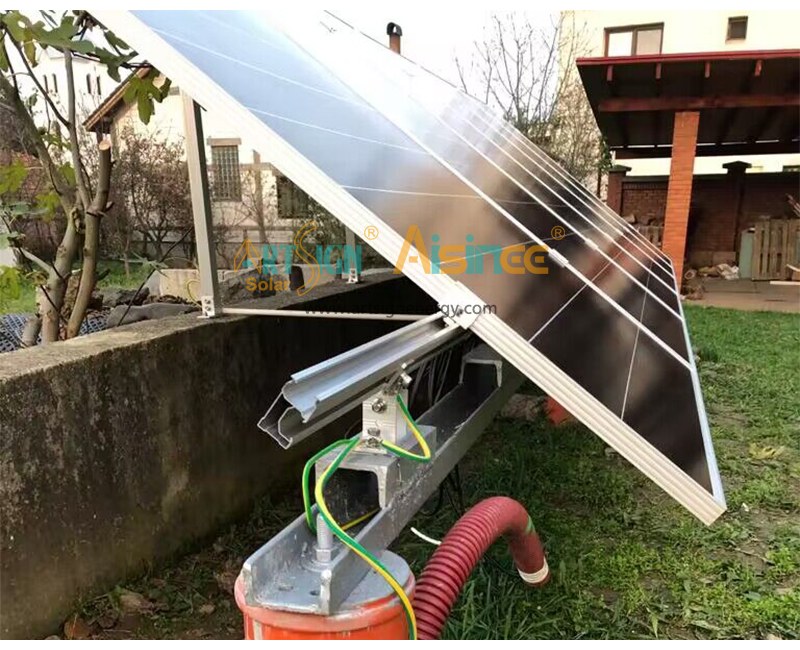
For any inquires for solar panels roof mounting system, please feel free to contact us.
E-mail: sales@artsign.net.cn,
Whatsapp / Wechat / Skype:+86-18030235875, thanks.